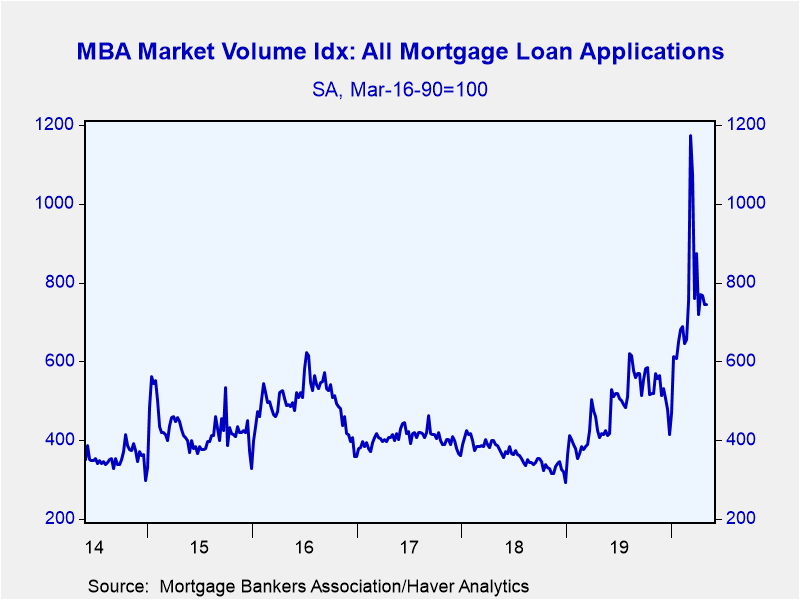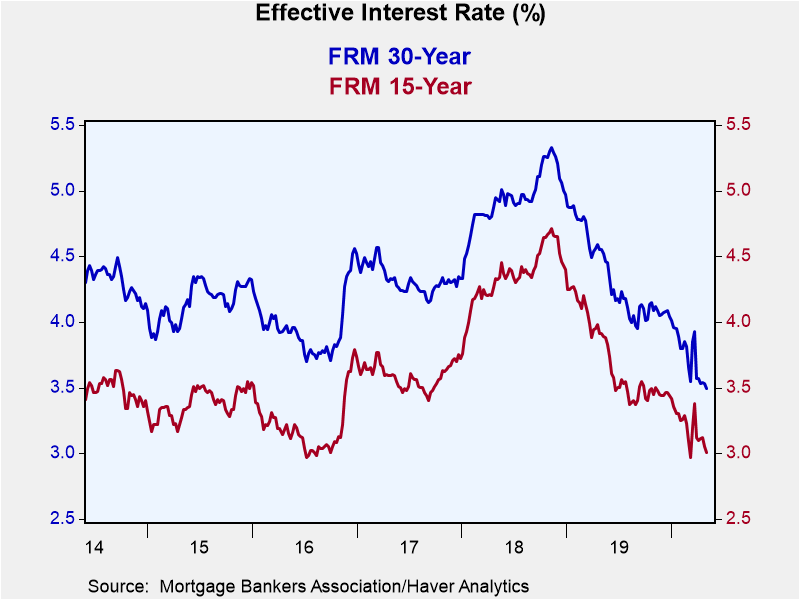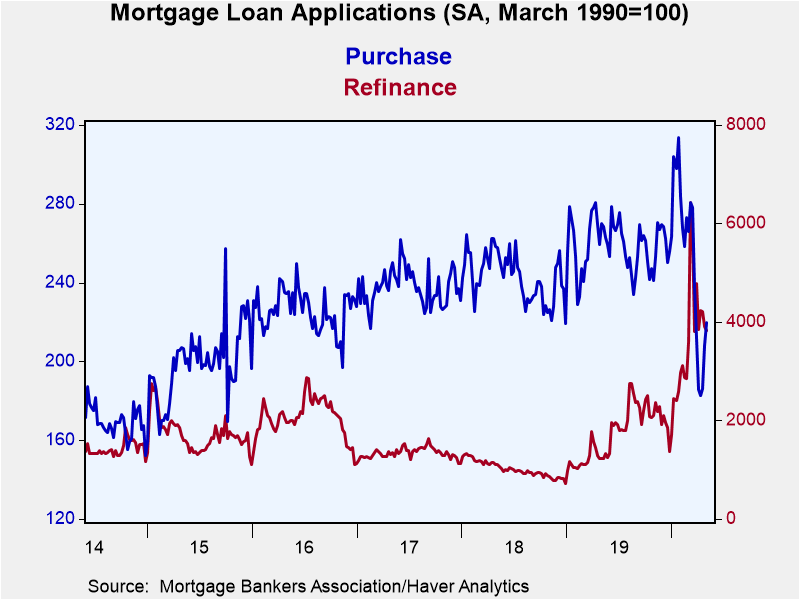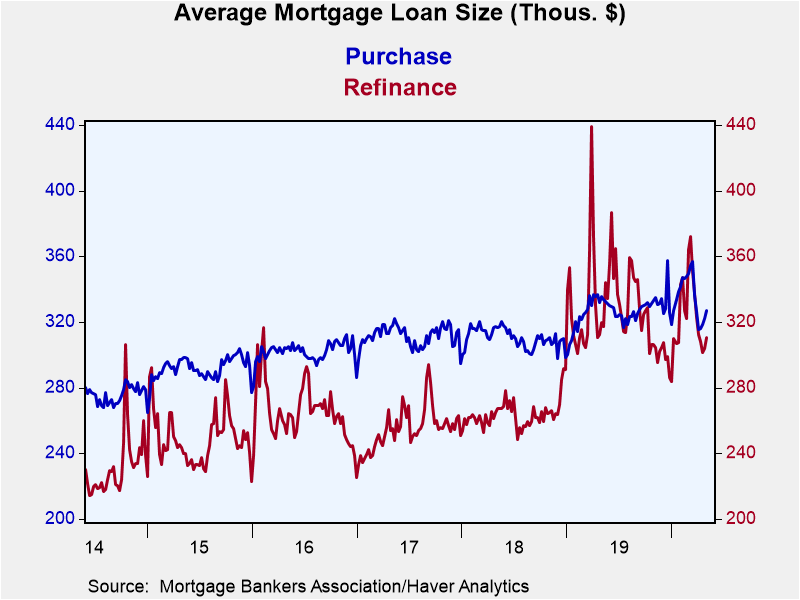 Global| May 06 2020
Global| May 06 2020U.S. Mortgage Applications Flat; Rates Fall Further
by:Sandy Batten
|in:Economy in Brief
Summary
• Financing rates fall and are at or near record lows. • Purchase volume rose for third consecutive week as some states begin to reopen. The Mortgage Bankers Association reported that its Mortgage Loan Application Index edged up 0.1% [...]
• Financing rates fall and are at or near record lows.
• Purchase volume rose for third consecutive week as some states begin to reopen.
The Mortgage Bankers Association reported that its Mortgage Loan Application Index edged up 0.1% w/w (+67.8% y/y) in the week ended May 1 following a 3.3% w/w decline in the previous week. Led by strong growth in Arizona, Texas and California, applications for purchase rose for the third consecutive week, increasing 5.8% w/w (-18.8% y/y) on top of a 11.6% w/w rise in the previous week as they continue to recover from a nearly five-year low. There appears to be some pent-up demand for home purchases as some states begin to reopen.
Applications for refinancing fell for the third consecutive week, declining 1.7% w/w (+209.7% y/y) after a 7.3% w/w decline in the previous week. Despite lower rates in general, some lenders are charging higher rates for refinancings than for purchases. Moreover, some have suspended cash-out refinance loans because these currently cannot be sold to Fannie Mae or Freddie Mac. The refinancing share of mortgage activity decreased to 70.0% of total applications from 71.6% the previous week. The adjustable-rate mortgage (ARM) share of activity increased to 3.0% of total applications.
The effective interest rate on a 15-year fixed-rate mortgage fell to 3.01% in the week ended May 1 from 3.05% in the previous week. This rate is now within four basis points of an all-time low for this series (dating back to 1990). The effective interest rate on the 30-year fixed-rate mortgage declined to 3.49, a record low for the series, from 3.53%. The effective rate on a 30-year Jumbo mortgage dropped to 3.79% from 3.81%. The rate on the 5-year adjustable rate mortgage rose for the second consecutive week to 3.33% from 3.29%.
The average mortgage loan size rose to $315,400 from $309,200. The average loan size of refinancings increased to $310,500 from $304,100. The average loan size for purchases rose to $326,800 from $321,900.
Home buyers and owners continue to lock in currently low levels of interest rates. Applications for fixed-rate loans increased 84.5% y/y, while applications for adjustable rate loans fell 17.4% y/y.
The survey covers over 75% of all U.S. retail residential mortgage applications and has been conducted weekly since 1990. Respondents include mortgage bankers, commercial banks and thrifts. The base period and value for each index is March 16, 1990=100. The figures for weekly mortgage applications and interest rates are available in Haver's SURVEYW database.
| MBA Mortgage Applications (%, SA) | 05/01/20 | 04/24/20 | 04/17/20 | Y/Y | 2019 | 2018 | 2017 |
|---|---|---|---|---|---|---|---|
| Total Market Index | -3.3 | -0.3 | 7.3 | 72.2 | 32.4 | -10.4 | -17.8 |
| Purchase | 11.6 | 2.1 | -1.8 | -20.2 | 6.6 | 2.1 | 5.6 |
| Refinancing | -7.3 | -0.8 | 10.1 | 217.6 | 71.1 | -24.3 | -34.0 |
| 15-Year Effective Mortgage Interest Rate (%) | 3.05 | 3.12 | 3.11 | 3.91 | 3.71 | 4.35 | 3.59 |
| 30-Year Effective Mortgage Interest Rate (%) | 3.53 | 3.54 | 3.53 | 4.55 | 4.34 | 4.94 | 4.32 |
Sandy Batten
AuthorMore in Author Profile »Sandy Batten has more than 30 years of experience analyzing industrial economies and financial markets and a wide range of experience across the financial services sector, government, and academia. Before joining Haver Analytics, Sandy was a Vice President and Senior Economist at Citibank; Senior Credit Market Analyst at CDC Investment Management, Managing Director at Bear Stearns, and Executive Director at JPMorgan. In 2008, Sandy was named the most accurate US forecaster by the National Association for Business Economics. He is a member of the New York Forecasters Club, NABE, and the American Economic Association. Prior to his time in the financial services sector, Sandy was a Research Officer at the Federal Reserve Bank of St. Louis, Senior Staff Economist on the President’s Council of Economic Advisors, Deputy Assistant Secretary for Economic Policy at the US Treasury, and Economist at the International Monetary Fund. Sandy has taught economics at St. Louis University, Denison University, and Muskingun College. He has published numerous peer-reviewed articles in a wide range of academic publications. He has a B.A. in economics from the University of Richmond and a M.A. and Ph.D. in economics from The Ohio State University.










